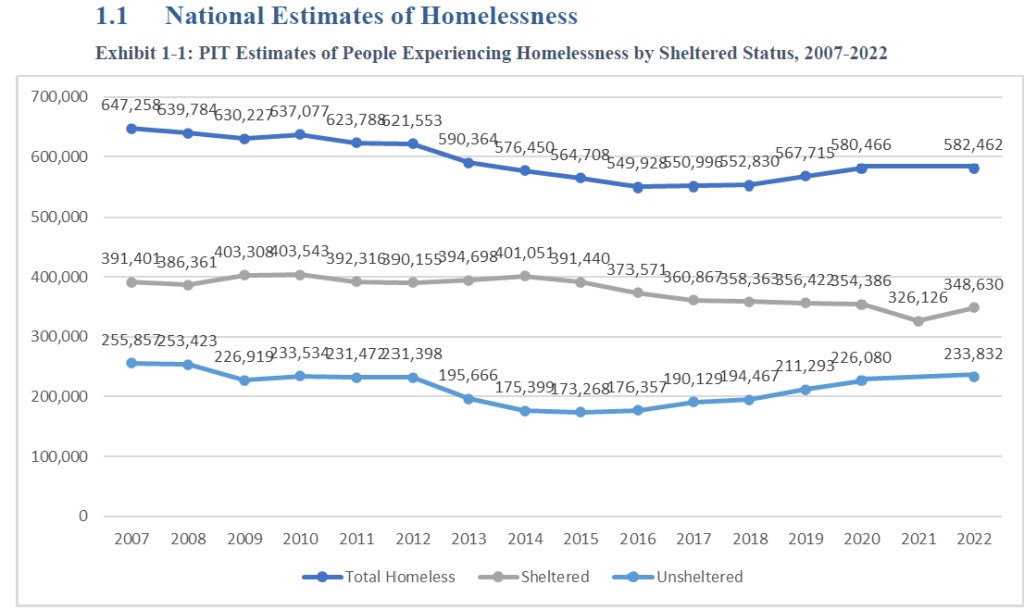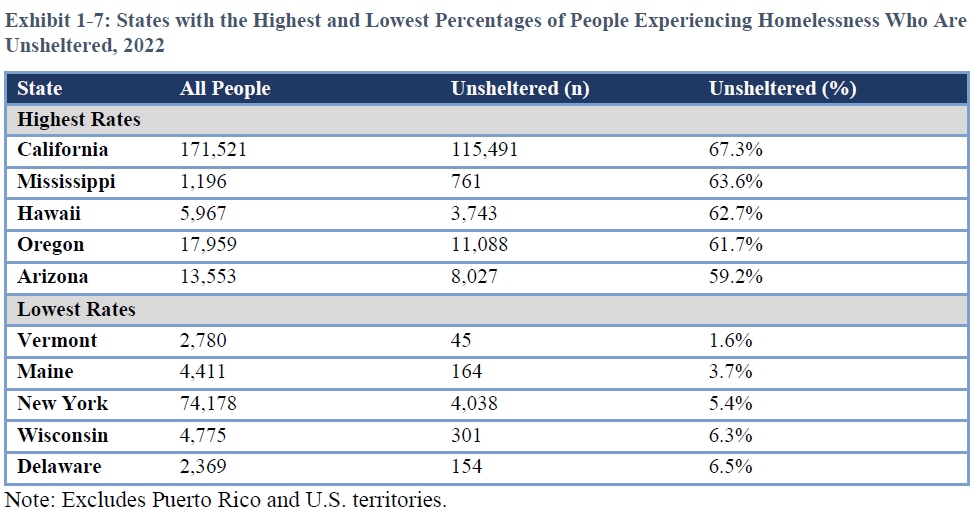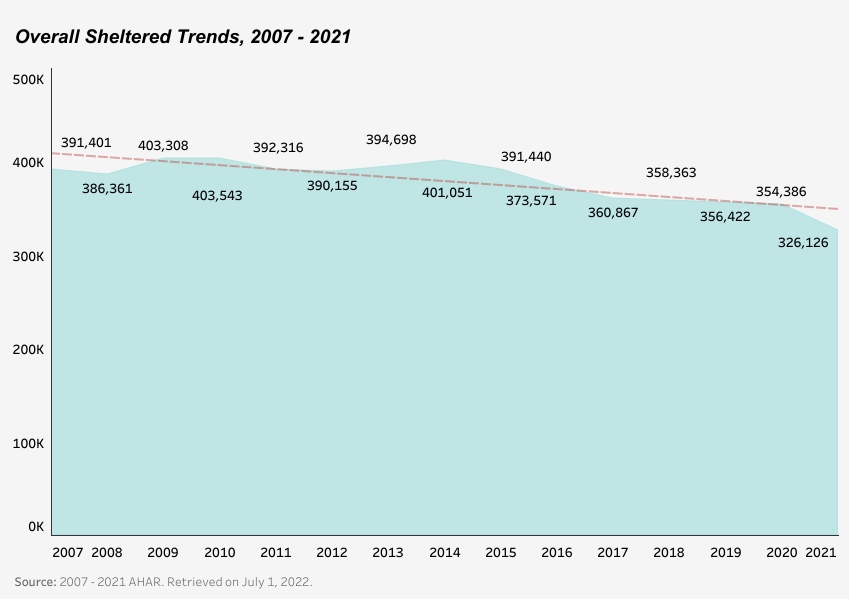Comments
- No comments found

Each year the US Department of Housing and Urban Development conducts a “point-in-time” survey in which it seeks to count the number of homeless on one night in January.
Because the point-in-time survey is conducted with the same methods each year, it offers a way of looking at trends in homelessness over time. The 2022 Annual Homeless Assessment Report (AHAR) to Congress was published a couple of weeks ago.
Here’s a figure showing trends for the last 15 years. As you see, there’s no datapoint for 2021, because the pandemic led to the survey being cancelled that year. In a big-picture sense, overall homelessness seemed to be on a downward, if slow, trend up to about 2018, and then rose. The bottom two lines show that if you break up the overall pattern, “sheltered” homelessness continued to decline up to the pandemic, but “unsheltered” homelessness rose.

The variation in rates of homelessness across states is considerable. Here are the states with the highest and lowest proportions of homeless, relative to their populations. One interesting pattern here is that a high level of homelessness is concentrated in western states. Specifically, California has both the highest proportion of homeless people and by itself account for half of all the unsheltered homeless in the United States Another is that New York state, perhaps counterintuitively, has had considerable success in keeping its proportion of homeless relatively low–and in providing shelter for those who are homeless.

The survey offers a detailed breakdown of homelessness by a variety of factors: for example, three-quarters of the homeless are over age 24 and 60% are men. For a discussion that includes the numbers and also goes beyond them, I find it useful to turn to the State of Homelessness: 2022 Edition, a target="_blank" report published annually by the National Coalition to End Homelessness. That report notes:
Long-term progress has been modest. In 2020, the number of unhoused people was only 10 percent lower than in 2007 (the first year of nationwide data collection). … While overall progress on ending homelessness has been modest, there is significant variation among subgroups. Some have experienced striking reductions in their counts.
Veterans are a good example. Currently, 83 communities and 3 states have announced that they ended veteran homelessness (meaning that systems can ensure that homelessness is rare, brief, and one-time). Nationally, veteran homelessness decreased 47 percent since the point at which it peaked in 2009. Homeless families with children are another group that decreased in size — 27 percent between 2007 and 2020.
Another pattern is that the number of people in shelters seems to be dropping, but for complex reasons. The report notes:
An easy assumption would be that systems are failing—that they’re providing fewer people with shelter, leaving more and more people to sleep outside. However, the reality is much more complicated.
Overall, homeless services systems have actually increased their capacity to serve people. … [S]ystems have been steadily growing their available bed numbers. However, they have been increasingly focusing their resources on permanent housing rather than temporary shelter. Thus, more and more people may be benefitting from housing and services, but an increasing share is living in permanent housing as opposed to languishing in temporary shelters. Further, growth in overall bed numbers is likely failing to keep pace with the number of new people entering homelessness, and specifically unsheltered homelessness.

The main policy push in the last 15 years or so has been “housing first”–where the guiding philosophy is to get the homeless into (potentially) permanent housing as soon as possible. As the report notes: “Currently, 59 percent of all homeless system beds are designated for permanent housing.” While I have no great quarrels with “housing first” as a starting point, it seems to me to glide over some of the differences across the homeless population. For some, a one-time boost into permanent housing can be the major part of what they need to get their life back on track. For others, issues like substance abuse or mental health are issues that may need to be addressed if the “permanent” housing is to actually work over time. In different cities and states, the cost of providing “permanent” housing can differ considerably. And there are multiple meanings of “permanent”: one is that you can stay without fear of being sent out again in a day or a week or a month; another is that you would prefer to stay there, given the other subsidized housing options in your area. In these ways and others, homelessness is a multidimensional problem.
Timothy Taylor is an American economist. He is managing editor of the Journal of Economic Perspectives, a quarterly academic journal produced at Macalester College and published by the American Economic Association. Taylor received his Bachelor of Arts degree from Haverford College and a master's degree in economics from Stanford University. At Stanford, he was winner of the award for excellent teaching in a large class (more than 30 students) given by the Associated Students of Stanford University. At Minnesota, he was named a Distinguished Lecturer by the Department of Economics and voted Teacher of the Year by the master's degree students at the Hubert H. Humphrey Institute of Public Affairs. Taylor has been a guest speaker for groups of teachers of high school economics, visiting diplomats from eastern Europe, talk-radio shows, and community groups. From 1989 to 1997, Professor Taylor wrote an economics opinion column for the San Jose Mercury-News. He has published multiple lectures on economics through The Teaching Company. With Rudolph Penner and Isabel Sawhill, he is co-author of Updating America's Social Contract (2000), whose first chapter provided an early radical centrist perspective, "An Agenda for the Radical Middle". Taylor is also the author of The Instant Economist: Everything You Need to Know About How the Economy Works, published by the Penguin Group in 2012. The fourth edition of Taylor's Principles of Economics textbook was published by Textbook Media in 2017.
Leave your comments
Post comment as a guest